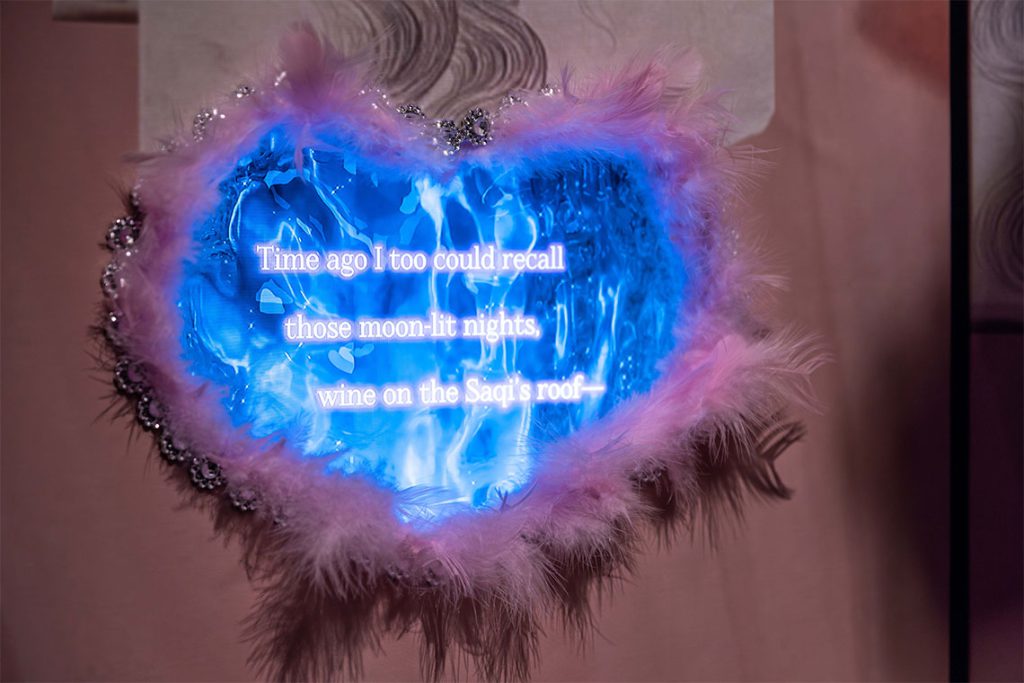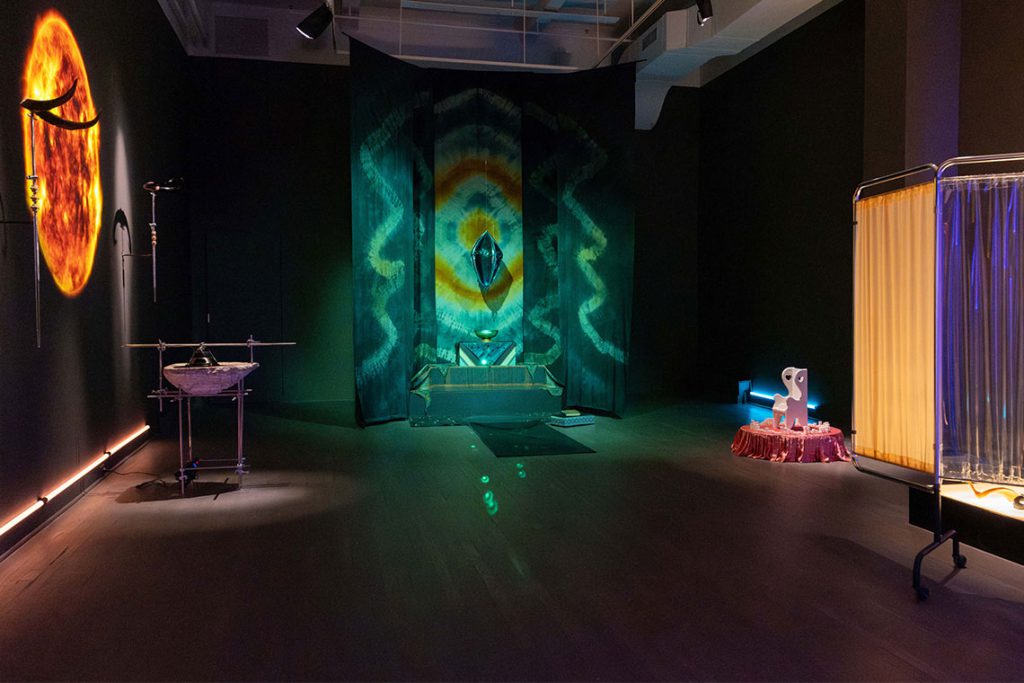The group exhibition at CUE Art Foundation assumes its title from a Persian wedding tradition to reflect on life’s mysterious ways.
Sun radiates its scorching amber hue in the group exhibition The Bride Has Gone to Pick Flowers. In Georgian artist Levani’s installation the altar (2025), the sun dances as a globular flame, projected onto a black-painted wall and bookended by two gazelle horns affixed onto two stainless steel and ceramic structures. Textures and material coalesce: light, dark, soft, hard and scolding are all alchemised into an enigmatic vignette which is only pushed to further mystery with a pink marble basin crowned with a complicated hardware structure right by the sun. Black-ink water fills the hand-carved sink. A recording of protestors chanting on Tbilisi streets following Georgia’s nearing to authoritarianism grants another layer materiality – in this case sonic vibrations – into Levani’s mercurial installation.
Suspense, in fact, veils the entire show, which also features work by Levon Kafafian and Fatemeh Kazemi and is organised by Lila Nazemian. The show’s title refers to a Persian wedding ritual, according to which the bride acts hesitant to say “yes” and the guests deliver quirky excuses for her supposed reluctance. Playful and performative, the custom acts upon typical matrimonial roles and exceptions, albeit with a spectral twist. Here, the excuse reads as a poetic line of absence in search of beauty. There is a sense of delay and anticipation as well as dedication to beautify.

In contrast, Nazemian’s orchestration at CUE is moody, absorbent with her selection of visually and materialistically layered installations within a dim setting. Kazemi’s Saqi (2024–25), for example, is a pink three-part MDF partition that holds digital prints of images that include a heart-shaped cut-out of two men. Two screens – also heart-shaped and outlined with feathers – each loop poetic verses: “Time ago I too could recall those moon-lit nights, wine on the Sadiq’s roof” and “But Time’s shelved them now in its niche, in Memory’s dim places”. From the middle of the divider hangs a bunch of green tassels bound with chains, and on the adjacent wall a bundle of faux-plastic gapes in various shades of green replicates a heart shape as well. Unrequited love, memory and ambiguity linger in the Iranian artist’s display of everyday materials and images in a demure language.
Kafafian’s Mirror of Fate (2025), a green-lit shrine of silk panels, various fabrics, a mirror and a book, occupies the gallery’s focal point. Both ethereal and rooted, the juxtaposition salutes the Armenian holiday of hampartsoum, which returns every May in celebration of nature’s blossoms and love. The installation – a world within a world – has an aquatic feel through the dyed silk’s swirling abstractions, while a suspended diamond-shaped leather object hovers above a glass bowl and shimmers and reflects the silk’s emerald hues. A lush satin rug, entitled Pools of Liquid Time (2025), spreads across the floor with bead and resin pieces. A sense of fluidity, even liquidity, washes over the Detroit-based artist and cloth-maker’s devotional composition, elevated into a multi-sensory statement with Lara Sarkissian’s accompanying celestial soundscape. Magical and covert, the work slows down time, prompting us to plunge into an alternative temporality of textures, light and sound.

A bride remains amiss throughout the show. Her abrupt disappearance and hopeful return, however, live entangled, yielding moments of mundane sanctity. In lieu of a wedding’s communal bliss meanders a ceremonial search, perhaps of the bygone bride and the self’s place in histories and memory. The title of Kazemi’s other installation, Yalan Dünya (2024–25), literally translates as ‘ world, the liar’ in Turkish, but it metaphorically refers to the impermanent transience of life. The poetic and somewhat sombre expression signals a displeasure with the tangible world and reminds us of its unpredictability and unfairness. Heart-shaped sugar cubes, in a pile over and around a chair, each read “Yalan Dünya,” imbuing the saccharine promise with reminder of the cosmos’s innate precariousness.



